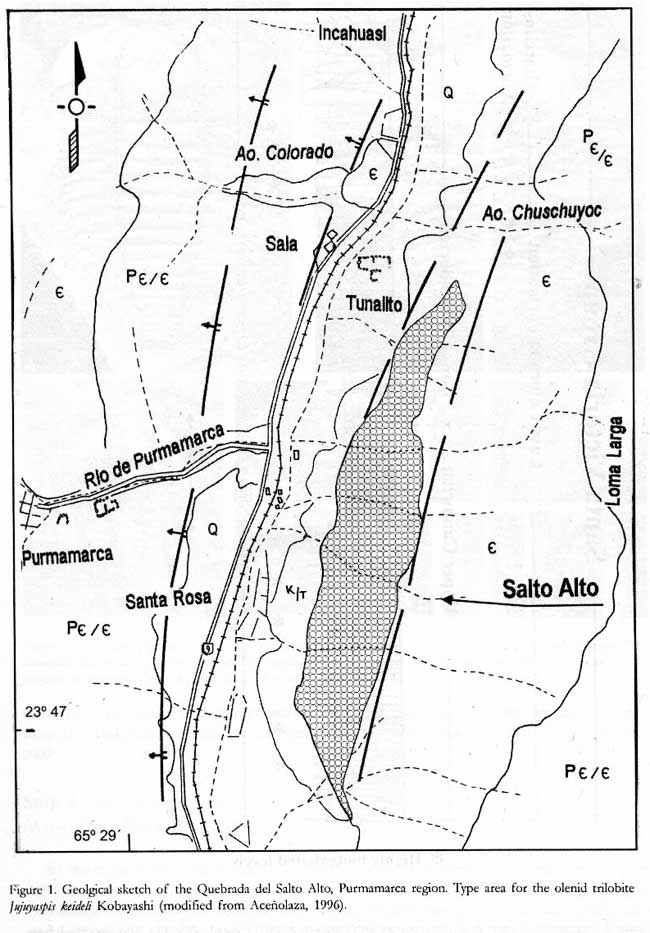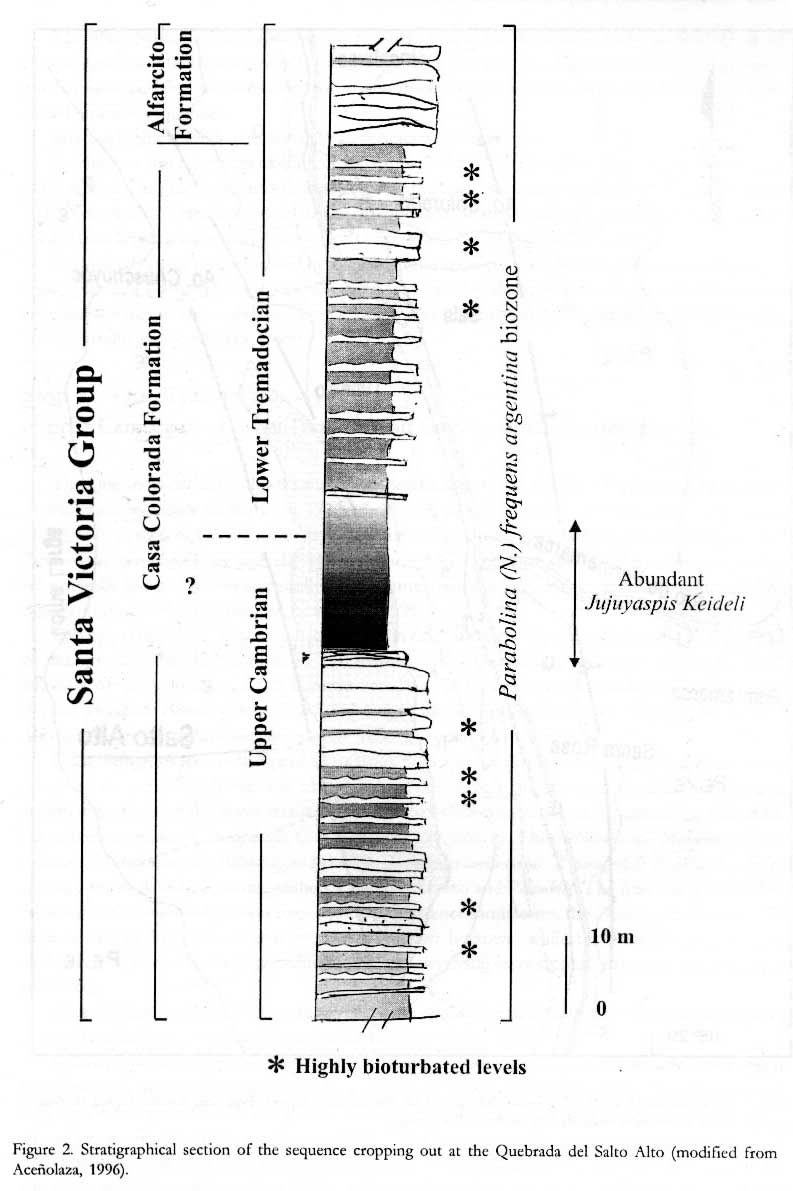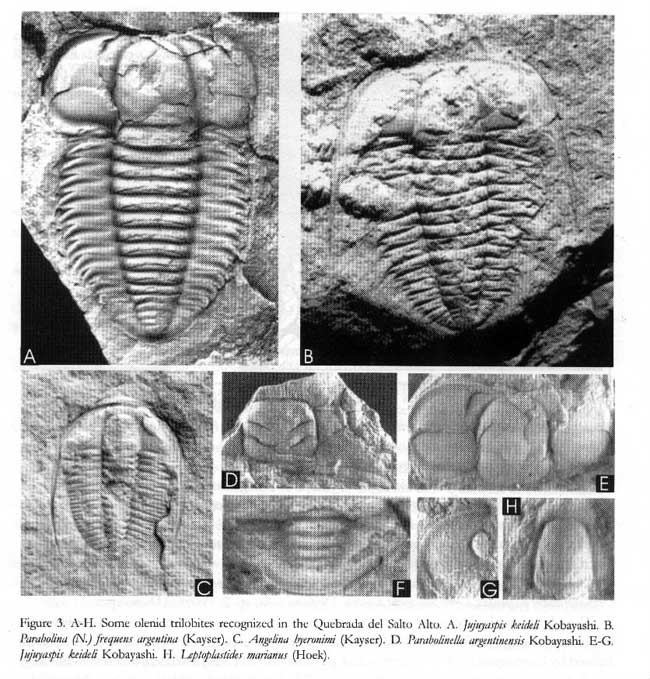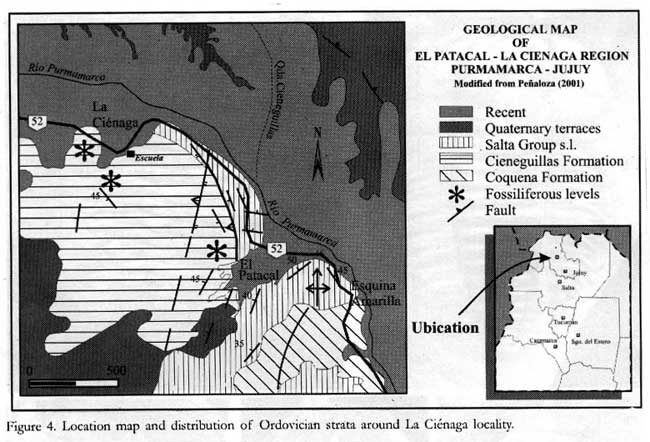
Upper Cambrian – Arenig stratigraphy and biostratigraphy in the Purmamarca area, Jujuy Province, NW Argentina
Guillermo F. ACEÑOLAZA1) and Sergio M. NIEVA1)
1) INSUGEO – Conicet/Facultad de Ciencias Naturales e I.M.L. Universidad Nacional de Tucumán, Miguel Lillo 205, 4000 Tucumán. E-mail: insugeo@unt.edu.ar
Palabras clave: Estratigrafía. Bioestratigrafía. Ordovícico. Purmamarca. Jujuy. Argentina.
Key words: Stratigraphy. Biostratigraphy. Ordovician. Purmamarca. Jujuy. Argentina.
Introduction
The region of Purmamarca is a classical locality for geological studies in the argentine literature. Many authors have recognized and analyzed the Ordovician strata and its paleontological heritage (eg. Keidel, 1917; Kobayashi,1936, 1937; Harrington, 1938; De Ferraris, 1940; Harrington and Leanza, 1957; Ramos et al., 1967 and Tortello, 1990).
However, strata are several times sliced by longitudinal faults of submeridional trend, cropping out in narrow belts alternating with Precambrian/Cambrian, Cambrian and Mesozoic units. As long ago stated by Harrington (1957), no continuous section is displayed, recording isolated Ordovician blocks of different stratigraphic position.
Several Lower Ordovician units crop out in the Purmamarca area. The Casa Colorada Formation (Uppermost Cambrian – Lower Tremadocian) is widely represented by the eastern flank of the Quebrada de Humahuaca when meeting the Quebrada de Purmamarca. The Coquena and Cieneguillas shales (Upper Tremadocian), and the Sepulturas Formation (Arenig) are nicely displayed in the tributaries of the Quebrada de Purmamarca.
Finally, it is worthwhile to mention that a paleontological collection from this South American locality was given to the renowned Japanese paleontologist Teiichi Kobayashi in the first decades of the XX century (Kobayashi, 1936). Within the material was a new trilobite genus, defined by him as Jujuyaspis (after Jujuy province). At that time, the senior author could not preview the importance of the cosmopolitan olenid trilobite Jujuyaspis for the Lower Ordovician biostratigraphical scheme. Nowadays, the genus has become one of the reference fossils for the base of the Ordovician System worldwide (Nordford, 1969; Nikolaisen and Henningsmoen, 1985; Bruton et al., 1988; Aceñolaza and Aceñolaza, 1992; Miller and Stitt, 1995; Miller and Taylor, 1995; Shergold, 2000; Tortello et al., 2002).
Stratigraphy and Biostratigraphy
The Quebrada de Purmamarca exposes different levels of the ichnofossiliferous Vendian/Tommotian Puncoviscana Formation; the Cambrian Mesón Group and the Tremadoc-Arenig Coquena, Cieneguillas and Sepulturas formations.
The Puncoviscana Formation crops out extensively by the access route to the village of Purmamarca, and few km westwards La Ciénaga. This unit is represented by interbedded greenish grayish slates and fine sandstones up to 1 meter thick. Frequent sedimentary structures have been found on these sequences.
Strata is highly folded an tectonically in contact with other units.
Sandstones and quartzites of The Mesón Group (Mid-Upper Cambrian) are widely distributed in the region. The unit is unconformably lying over the Puncoviscana Formation (Pampean Orogeny = Tilcaric phase). Trace fossils are the most abundant elements among these strata, while scarce shelly fauna is recorded in very few localities (Aceñolaza G., 2003 with references).
Ordovician strata is represented by an uncontinuous sequence of sandstones and shales of the Casa Colorada Formation; the Coquena and Cieneguillas shales and the Sepulturas limestones cropping out mainly arround the locality of La Ciénaga (Harrington, 1957, Aceñolaza, 1996; Tortello, 1996; Tortello and Aceñolaza, 1999).
Stop 1 - Quebrada del Salto Alto
(Upper Cambrian – Lower Tremadocian Casa Colorada Formation)
The Quebrada del Salto Alto is a small gore descending westwards from the Sierra Alta. A highly fossiliferous sequence of the Casa Colorada Formation (Harrington, 1957, emmend. López and Nullo, 1969) crops out in the lower sector of the Sierra. Strata are a faulted slice of the Cambro-Ordovician sequences, tectonically placed between quartzites of the Cambrian Mesón Group. Ichnofossils and a rich trilobitic shelly fauna dominate the fossiliferous record (Aceñolaza, 1996; Mángano et al., 1996; Tortello and Aceñolaza, 1999).
Jujuyaspis is by far the most abundant species in the Cambro-Ordovician pyritiferous black shales of this locality. Olenid trilobites of the Parabolina (N.) frequens argentina zone (Jujuyaspis keideli subzone of Tortello et al., 2002) is represented in the fossiliferous assemblage: Parabolina (N.) frequens argentina, Beltella ulrichi, Parabolinella argentinensis, Angelina hyeronimi, Anglagnostus sp. and Micragnostus sp. are mentioned among the most frequents elements.
Even though strata are disrupted by faulting, the sequence display a few interesting elements to be analyzed. Aceñolaza (1996) and Mángano et al. (1996), describe the trace fossil association and sedimentary facies of the lower sector of the sequence (tide dominated shelf), presenting Conostichus isp., Cruziana omanica, C. semiplicata, C. cf. tortworthi, Cruziana isp., Helminthopsis abeli, Monomorphichnus bilinearis, M. multilineatus, Palaeophycus tubularis, Rusophycus carbonarius, R. latus, and R. polonica. Three ichnocoenosis have been distinguished: Cruziana, Skolitos and Planolites. The first one is preserved on soles of thin-bedded planar cross-stratified quartzose sandstones; the Skolitos ichnocoenosis is represented by high to low density Skolithos linearis burrows, while the Planolites one consists exclusively of Planolites montanus within mudstones overlying wave rippled sandstones (Mángano et al., 1996).
Material described by Kobayashi (1936) most probably came from one of these small gores descending the Sierra Alta, as the Quebrada del Salto Alto.
Following sedimentary characters and paleontological evidence, the Casa Colorada Formation is interpreted as shoreface sedimented strata, within an upper offshore / middle shoreface setting. Deposit feeders are the dominant group reflected by trace fossils with a proportional less participation of suspension feeders (Di Cunzolo et al., 2003). An ichnoassociation dominated by elements of the "Cruziana and Skolithos ichnofacies" is recorded in the sandstones and quartzites of the sequence. On the basis of the sedimentological patterns and ichnological record, the sandstone intercalations



within the shalier sector of the Casa Colorada Formation and equivalent units were interpreted as storm layers inhabited by oportunistic faunas (Aceñolaza, 1996; Aceñolaza, 2001, Di Cunzolo et al., 2003).
Stop 2 - La Ciénaga locality
(Arenig Sepulturas Formation)
By the route to the Chilean border, a few km westwards of Purmamarca village, Harrington (1957) describes the Coquena shales as composed by "Dark gray to light yellowish-gray and greenish-gray thinly bedded, micaceous shaly sandstones, normally hard and lithified, alternating with thin layers of fine-grained sandstones, silstones, and silthy shales". Brachiopods (Obolus sp., Nannorthis sp.), molluscs (Bucania cyrtoglypha) and trilobites: Geragnostus callaveiformis, Trinodus jujuyensis, Shumardia (Conophrys) minutula,

Apatokephalus serratus, Notopeltis orthometopa, Nannopeltis modesta, Pliomeroides deferrarisi, Orometopus pyrifroms etc. are mentioned as the most abundant fauna in these Upper Tremadocian levels [Shumardia (Conophrys)-Notopeltis trilobite biozone)].
The earlier referred unit is tectonically followed by the Cieneguillas Formation. Strata was described by Harrington (1957) as "...Yellowish-green sandy shales with intercalated layers of greenish-gray sandstones and calcareous sandstones (exposed a little downstream from the Sepulturas limestones". Trilobites from this unit are represented by Thysanopyge argentina, Megalaspidella kayseri and Nannorthis sp. Rao et al. (1994) describes graptolites (Didymograptus (s.l.) aff. demissus, D. (s.l.) cf. simulans, D. (Corymbograptus) aff. vacillans) and conodonts (Baltoniodus crassulus andinus, Cornuodus longibasis, Drepanodus? sp., Drepanoistodus basiovalis, Drepanoistodus pitjanti, Drepanoistodus sp. 2, Protopanderodus sp.
The whole unit displays good outcrops along route 59, close to El Patacal and La Ciénaga area. In the last locality, Aceñolaza F. (2003) recognizes the type area for the Sepulturas Formation as defined by Harrington (1957) "...Light to dark gray limestones and marly limestones, with interbedded dark gray shales (exposed in the upper Quebrada de Purmamarca)". Trilobites (Hoekaspis schlagintweiti and Pliomeridus sulcatus), graptolites, conodonts, trace fossils (Monomorphichnus isp, Cruziana isp.), nautiloids, brachiopods and bivalves are found in these strata.
References
Aceñolaza, F.G. and Aceñolaza, G.F., 1992. The genus Jujuyaspis as a world reference fossil for the Cambrian-Ordovician boundary. In: Webby, B. and Laurie, J.R. (Eds.) Global perspectives on Ordovician geology. Elsevier: 115-120.
Aceñolaza, G.F., 1996. Bioestratigrafía del límite Cámbrico-Ordovícico y ordovícico basal en la Quebrada de Humahuaca, Provincia de Jujuy, República Argentina. Unpublished Doctoral Thesis, Facultad de Ciencias Naturales e IML, National University of Tucumán, 245 p.
Aceñolaza, G.F., 2001. Icnofòsiles Cambro-Ordovícicos asociados a facies de lutitas negras: el caso de la Formación Lampazar en el noroeste argentino. IV Reunión Argentina de Icnología y 2da Reunión de Icnología del Mercosur. Resúmenes, 18.
Aceñolaza, G.F., 2001. The Cambrian System in Northwestern Argentina: stratigraphical and palaeontological framework. Geologica Acta, 1(1): 23-39.
Bruton, D.L., Koch, L. and Pepetski, J.E. 1988. The Naersnes section, Oslo Region, Norway: Trilobite, graptolite and conodont fossils reviewed. Geological Magazine 125: 451-455.
De Ferraris, C., 1940. Corrimiento de los bloques de montaña en los alrededores de Purmamarca, Departamento de Tumabaya (Prov. de Jujuy). Museo de La Plata Tesis Nº 1. La Plata.
Di Cunzolo, S., Aceñolaza, G.F. and Rodríguez-Brizuela, R., 2003. ¨Cruziana-Skolithos¨ ichnoassociation in the Casa Colorada Formation (Upper Cambrian-Tremadocian), Cordillera Oriental of Jujuy province, NW Argentina. INSUGEO, Serie Correlación Geológica 17.
Harrington, H.J. 1938. Sobre las faunas del Ordoviciano inferior del Norte argentino. Revista del Museo de La Plata (Nueva Serie), Sección Paleontología 1: 209-289.
Harrington, H.J. 1957. Ordovician Formations of Argentina. En: H.J. Harrington y A.F. Leanza, Ordovician Trilobites of Argentina. Department of Geology, University of Kansas, Special Publication 1: 1-59.
Harrington, H. J. y Leanza, A.F. 1957. Ordovician Trilobites of Argentina. Department of Geology, University of Kansas, Special Publication 1: 276 p.
Keidel, H. 1917. Noticia sobre exploraciones geológicas en la Provincia de Jujuy. Physis 3: 112 p..
Kobayashi, T. 1936. On the Parabolinella fauna from Province Jujuy. Argentina. Japan Journal of Geology and Geography 13: 85-102.
Kobayashi, T. 1937. The Cambro-Ordovician shelly faunas of South America. Journal of the Faculty of Science, Imperial University of Tokyo, Section 2, 4: 369-522.
López, C.R. y Nullo, F.E. 1969. Geología de la margen izquierda de la Quebrada de Humahuaca, de Huacalera a Maimará, Departamento Tilcara, Provincia de Jujuy, República Argentina. Revista de la Asociación Geológica Argentina 24: 173-182.
Mángano, M.G., Buatois, L.A. and Aceñolaza, G.F., 1996. Trace fossils and sedimentary facies from a Late Cambrian-Early Ordovician tide dominated shelf (Santa Rosita Formation, northwestern Argentina): implications for ichnofacies models of shallow marine successions. Ichnos 5: 53-88.
Miller, J.F. and Stitt, J.H., 1995. Starigraphic position and significance of Jujuyaspis and Iapetognathus in the Wliberns Formation, Texas, p. 105-108. In J.D. Cooper, M.L. Droser, and S.C. Finney (eds.), Ordovician Odyssey: Short Papers for the seventh International Symposium on the Ordovician System, Las Vegas, SEMP, Fullerton, California.
Miller, J.F. and Taylor, M.E., 1995. Biostratigraphic significance of Iapetognathus (Conodonta) and Jujuyaspis (Trilobita) in the House Limestone, Ibex area, Utah, p. 109-112. In J.D. Cooper, M.L. Droser, and S.C. Finney (eds.), Ordovician Odyssey: Short Papers for the seventh International Symposium on the Ordovician System, Las Vegas, SEMP, Fullerton, California.
Nikolaisen, F. and Henningsmoen, G., 1985. Upper Cambrian and Lower Tremadocian olenid trilobotes from the Digermul peninsula, Finnmark, Northen Norway. Norges Geologiske Undersogelse, Bulletin 400: 1-49.
Nordford, B.S., 1969. The Early Canadian (Tremadocian) trilobites Clelandia and Jujuyaspis from the southern Rocky Mountains of Canada. Geological Survey of Canada, Contributions to Canadian Paleontology, Bulletin, 182: 1-15, 56-59.
Ramos, V., Turic M. and Zuzek, A., 1967. Geología de las quebradas de Huchaira-Pocoya, Purmamarca y Tumbaya Grande, en la margen derecha de la Quebrada de Humahuaca (Prov. de Jujuy). Asociación Geológica Argentina Revista 22: 209-221.
Rao, R.I. and Hünicken, M.A., 1995. Conodontes del Cámbrico Superior-Ordovícico inferior en el area de Purmamarca, Cordillera Oriental, Provincia de Jujuy, R. Argentina. Boletín de la Academia Nacional de Ciencias, Córdoba. 60 (3-4): 249-266.
Shergold, J.H., 2000. The Early Ordovician trilobite genus Jujuyaspis in Australia. In Aceñolaza, G.F. and Peralta, S. (eds.), Cambrian from the southern edge. p.128.
Tortello, M.F., 1995. El Orden Agnostida(Trilobita, Cámbrico-Ordovícico) en la República Argentina. Unpublished Ph.D. thesis, Facultad de Ciencias Naturales y Museo, Universidad Nacional de La Plata, Argentina. 295 p.
Tortello, M.F. 1996. Geragnostus nesossii Harrington y Leanza, 1957 (Trilobita, Agnostida) en el Tremadociano Superior del noroeste argentino. 13º Congreso Geológico Argentino y 3º Congreso de Exploración de Hidrocarburos 5: 17-25.
Tortello, M.F. and Aceñolaza, G.F., 1999. Trilobites agnóstidos del Ordovícico basal en la localidad de Purmamarca, Provincia de Jujuy, Argentina. Temas Geológico-Mineros ITGE, 26: 585-588.
Tortello, M.F., Esteban, S.B. and Aceñolaza, G.F., 2002. Trilobites from the base of the Ordovician System in Northwestern Argentina. In: Aceñolaza, F.G. (Ed.). Aspects of the Ordovician System in Argentina. INSUGEO, Serie Correlación Geológica 16: 131-142.